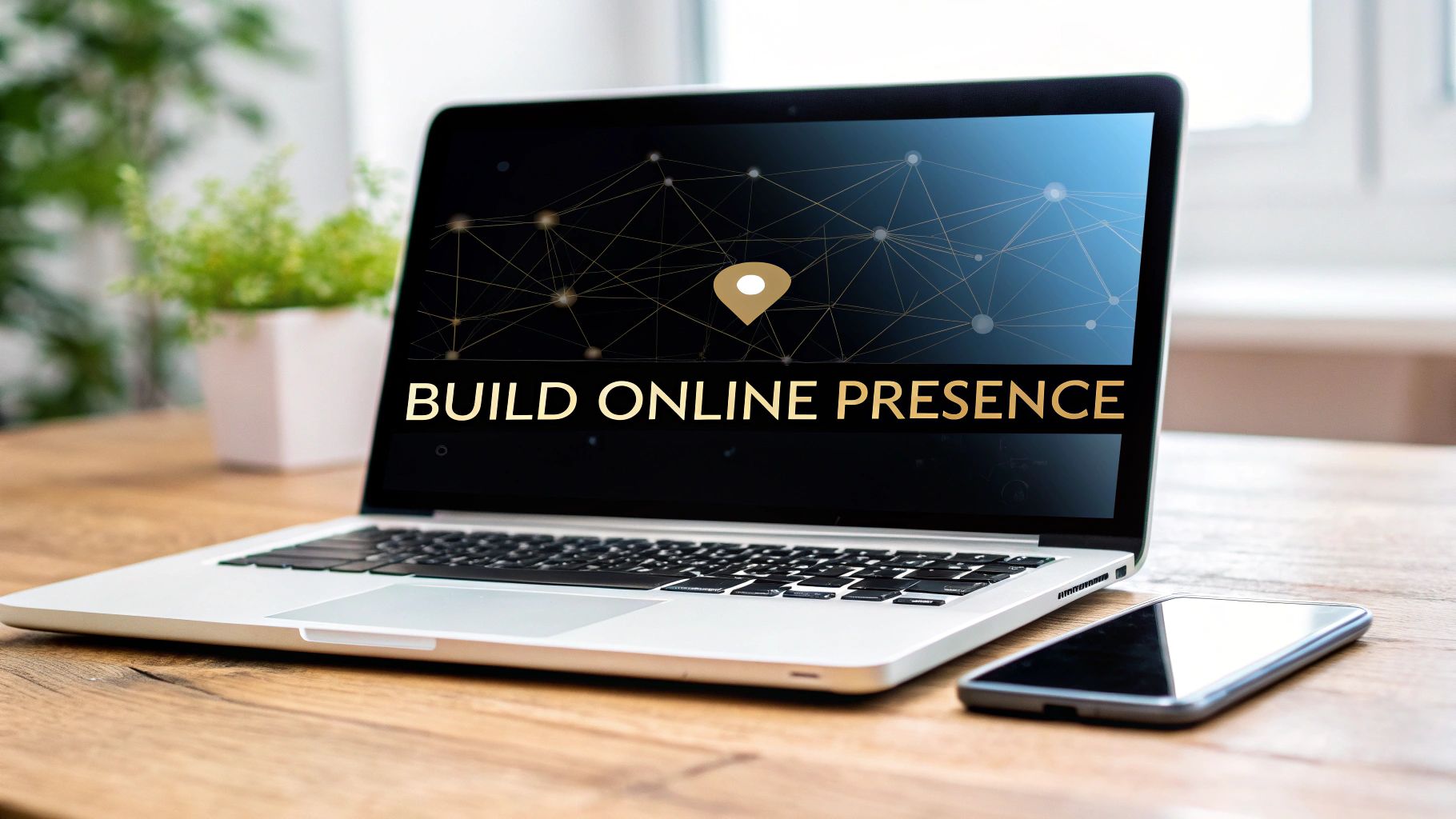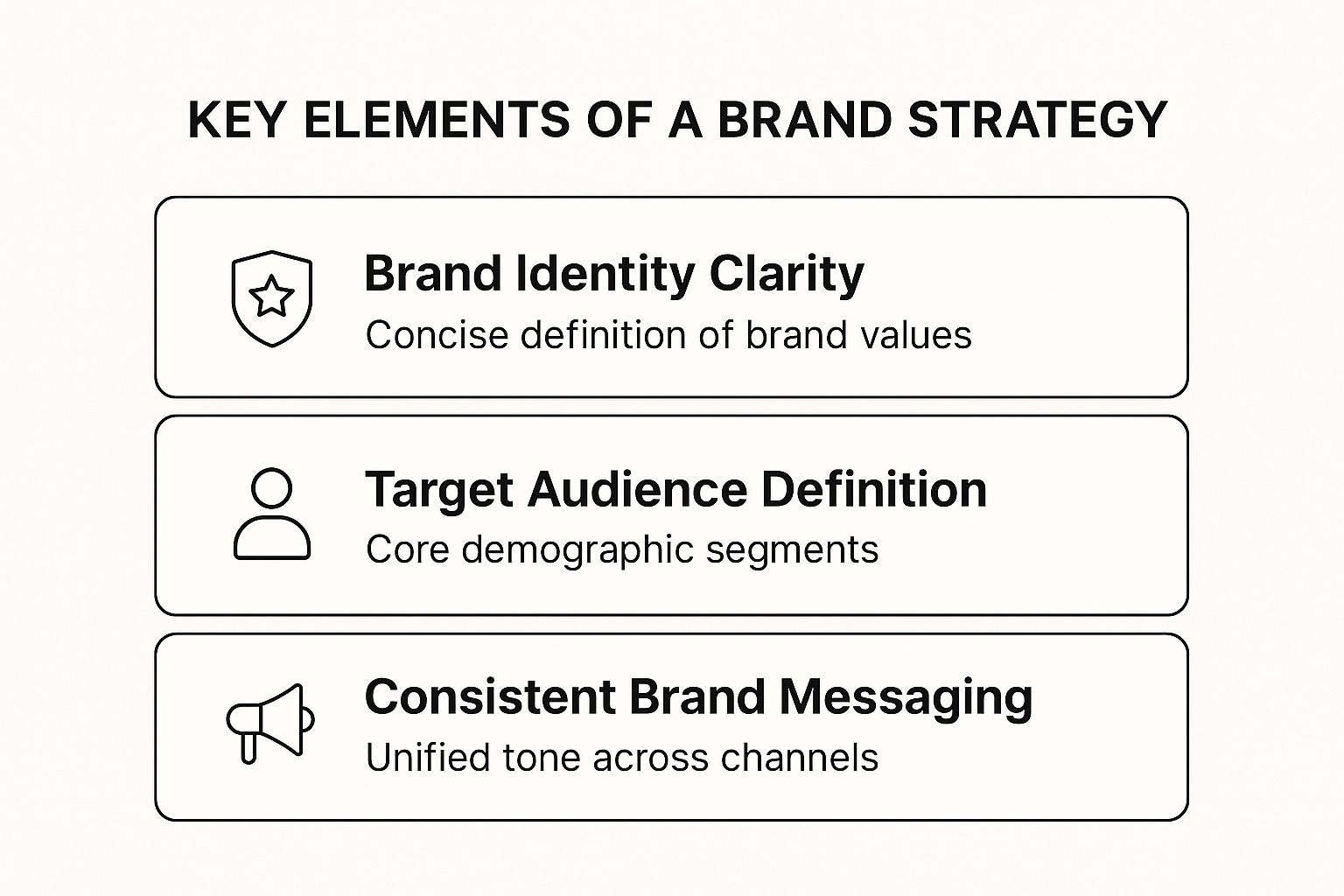
How to Build Online Presence That Accelerates Growth
Published on 2025-07-04
Before you even think about posting, you need to lay the groundwork. Building a powerful online presence isn't about shouting into the void; it's about creating a solid digital foundation first. This is where the real work begins.
Build Your Digital Foundation First
So many professionals get this backward. They jump straight into creating content, hoping something will stick. But without a clear strategy, it's like building a house without a blueprint—it’s a recipe for wasted effort and a whole lot of frustration.
Taking the time to build a strong foundation ensures every post you write, every connection you make, and every comment you leave is intentional. It’s about being deliberate, not just busy.
Define Your Core Message And Niche
First things first: what do you want to be known for? You have to get crystal clear on your unique value. Trying to be a jack-of-all-trades is a surefire way to get lost in the crowd. The real magic happens when you narrow your focus and own a specific niche.
For example, instead of just being a "financial advisor," you could be the go-to expert for "retirement planning for tech entrepreneurs." See the difference? That level of specificity makes it so much easier to create content that hits home and attracts the exact people you want to work with.
The goal is to move from a broad, generic topic to a sharp, focused niche. This is what separates the professionals who stand out from those who blend in. You need to own a specific conversation.
Your core message should be a simple, authentic statement that sums up this unique value. It becomes the guiding star for everything you do online.
Identify Your Target Audience
Once you know what you're saying, you need to figure out who you're saying it to. Creating content for "everyone" is a classic mistake that leads to connecting with no one. You need to get laser-focused on your ideal audience.
Think about them in detail:
- Demographics: What’s their job title, industry, or age range?
- Pain Points: What are the real challenges keeping them up at night that you can solve?
- Goals: What are their biggest professional or personal aspirations?
- Online Behavior: Where do they hang out online? What kind of content do they actually engage with?
This is all about putting the right message in front of the right people.

As you can see, your brand clarity, audience definition, and messaging all have to work together. When they do, you create an online identity that’s both powerful and impossible to ignore.
Set Clear And Measurable Goals
Why are you even doing this? Your online presence needs a purpose. Vague goals like "grow my following" won't cut it. You need goals that are specific, measurable, achievable, relevant, and time-bound (SMART).
Here are a few examples of what strong goals look like:
- Generate 5 qualified leads per month through my LinkedIn activity.
- Increase my LinkedIn profile views by 25% over the next three months.
- Land one speaking gig from my online network within the next six months.
To help you get started, here's a simple table to organize your foundational strategy. Answering these questions will give you the clarity you need to move forward with purpose.
| Core Components of Your Online Presence Strategy | | :--- | :--- | :--- | | Component | Key Question to Answer | Example | | Core Message | What is the unique value I offer in one sentence? | "I help SaaS founders scale their marketing without a massive ad spend." | | Niche | What specific problem do I solve for a specific group? | "Content strategy for early-stage B2B tech companies." | | Target Audience | Who is my ideal client or connection? | "Non-technical founders of SaaS startups with 10-50 employees." | | Primary Goal | What is the #1 outcome I want from my online efforts? | "Secure 2 new clients per quarter from LinkedIn." |
With these core components defined, you'll have a clear roadmap to guide your actions.
Clear goals keep you focused and allow you to see what's actually working. This strategic foundation is especially critical on a platform like LinkedIn, where a thoughtful approach can completely change your career trajectory. If you're ready to go deeper, check out our complete guide on how to build your personal brand on LinkedIn. A well-defined strategy isn't just a nice-to-have; it's your roadmap to real, measurable success.
Choose Your Key Platforms Wisely

One of the biggest myths holding professionals back is the idea that you need to be active everywhere online. The reality is quite the opposite. Spreading yourself too thin is a surefire way to burn out with very little to show for it.
The secret isn’t about being omnipresent; it’s about being present where it matters. Your goal should be to master one or two key platforms where your target audience actually lives and breathes. For most professionals, that conversation starts and ends with LinkedIn.
Why LinkedIn Is a Professional Powerhouse
LinkedIn has grown far beyond its old reputation as just a place to park your resume. It’s now the world's premier hub for professional networking, industry-specific discussions, and B2B marketing. With over 1 billion members globally, it's where you'll find decision-makers, thought leaders, and potential clients all in one place.
What makes LinkedIn so effective is the user's mindset. People aren't there to scroll through vacation photos; they're there to learn, connect, and grow their careers. This creates a focused environment where high-quality, valuable content doesn't just get seen—it gets respected and acted upon.
Of course, the digital world is vast. Projections show social media will hit 5.42 billion users by 2025, with the average person active on 6.83 different networks. The opportunity is massive, and you can dive deeper into these trends with these comprehensive social media statistics. But opportunity can also be a distraction.
Finding Where Your Audience Lives
To pick the right platform, you have to go back to the foundational work: knowing your audience inside and out. It’s time to put on your detective hat and figure out where these people genuinely spend their time.
Ask yourself some practical questions:
- Where do they ask for professional advice? Are they active in LinkedIn Groups, firing off questions on X (formerly Twitter), or deep in niche forums on Reddit?
- What kind of content do they consume? Do they read long, detailed articles (a good sign for a blog or LinkedIn) or prefer quick visual hits (pointing you toward Instagram or TikTok)?
- Who are the major voices in their field? See which platforms those influencers dominate. Their followers are very likely your target audience.
A software developer, for example, will find lively, technical conversations on X and specific subreddits. A consultant trying to land C-suite clients, however, will find those executives are almost exclusively on LinkedIn.
Don’t just assume where your audience is—prove it. Spend a week as a fly on the wall. Watch where the real, meaningful conversations are happening. That’s your spot.
Your Battleground: A Personal Blog vs. Social Media
A common crossroads professionals face is whether to focus their energy on a platform like LinkedIn or go all-in on building a personal blog. Each has its pros and cons, and the best choice really boils down to your goals.
| Platform Comparison | |
|---|---|
| Personal Blog | |
| Built-in Audience: You can immediately tap into a massive, existing network. | Total Ownership: You control everything—the design, the content, and the user data. |
| High Discovery Potential: The algorithm is built to push your content to a wide, relevant audience. | A Long-Term Asset: Your blog posts can rank on Google, driving organic traffic for years. |
| Made for Engagement: The platform is designed for comments, shares, and discussions. | Deeper Connection: A blog allows you to showcase your expertise in much greater detail. |
For most professionals just starting to build their online presence, the answer is simple: prioritize LinkedIn first. It provides instant feedback and a built-in distribution channel. You can test ideas, see what resonates, and build an initial following.
Once you’ve gained some momentum, you can launch a personal blog to serve as a central hub for your best long-form content. Then, you can use LinkedIn to drive traffic to it. This approach gives you the best of both worlds without overwhelming you right out of the gate.
Create Content That Truly Connects
Once your foundation is set and you know where you’ll be active online, it’s time to get to the heart of the matter: your content. This is the fuel for your growth. It's how you build an online presence that people actually care about, turning passive followers into a real community.
This isn’t about shouting your credentials into the void. It’s about sharing your expertise, your experiences, and your point of view in a way that makes people stop scrolling. The goal is to make them think, feel, and maybe even share what you have to say.
Turn Your Expertise into Engaging Stories
Your biggest asset is something no one else has: your unique experience. The tough projects, the lessons learned the hard way, and the wins you've celebrated are all incredible sources for content. People don't connect with dry data; they connect with real stories.
Think about a common headache in your industry. Don't just list the solutions. Tell a story about how you or a client navigated that exact problem. What went wrong? What was the “aha!” moment? What happened in the end? Framing it as a narrative makes your advice stick.
For example, a project manager could share a story about a project that was teetering on the edge of disaster and the one specific communication tactic that pulled it back from the brink. That’s far more powerful than a generic post about "the importance of good communication."
Your personal stories and real-world examples are your content superpowers. They're unique to you and build a level of trust and authority that generic advice can never match.
Master a Mix of Content Formats
To keep your audience hooked, you need to switch up how you present your ideas. Sticking to just one format can make your feed feel stale pretty quickly. On a platform like LinkedIn, a healthy mix of content types is essential for building and keeping momentum.
Here are a few formats you'll want to get comfortable with:
- Insightful Text Posts: These are the bread and butter of LinkedIn. Share a strong opinion, a personal reflection, or a practical tip. Keep your paragraphs short and use plenty of white space to make them easy to scan on a phone.
- Eye-Catching Carousels (PDFs): Carousels are brilliant for breaking down complex topics into digestible, visual slides. You can easily repurpose a blog post or a presentation into a compelling carousel that gets people swiping.
- Value-Packed Short-Form Videos: Video is a powerhouse. In fact, 78% of people prefer finding new products through short videos, and 93% of marketers plan to increase their use of social media marketing in 2025. You can get more details from these valuable social media findings. A quick 60-second video sharing one tip or answering a common question can have a huge impact.
By diversifying your formats, you appeal to different preferences and keep your feed feeling fresh. Nailing this mix is a core part of an effective content strategy for LinkedIn.
A Real-World Example of High-Performing Content
Let's walk through a type of post that almost always does well on LinkedIn. Imagine a founder who posts a simple text-only update.
- The Hook (First Line): "I made a $50,000 mistake so you don't have to." This immediately grabs attention with vulnerability and high stakes.
- The Story (Body): They briefly explain a bad hiring decision from their early days, focusing on the lesson learned, not just the failure itself. They keep the paragraphs to just one or two sentences.
- The Takeaway (Conclusion): They boil the experience down to three actionable tips for other founders to improve their own hiring process.
- The Call to Engagement (Final Line): "What's the biggest hiring lesson you've learned?" This invites conversation and makes it easy for others to jump in with their own stories.
This post works because it's personal, genuinely helpful, and starts a conversation. It’s not broadcasting; it's community-building.
Using AI as Your Creative Partner
Let's be real: creating a steady stream of great content is demanding. This is where AI tools can become an amazing partner, helping you scale your efforts without sounding like a robot.
Think of AI not as a replacement for your brain, but as a brainstorming assistant. Tools like autoghostwriter can help you:
- Generate Ideas: Feeling stuck? AI can serve up prompts and different angles on topics you already know inside and out.
- Beat Writer's Block: It can get that first rough draft on paper, which you can then polish with your personal stories and unique voice.
- Repurpose Content: Feed a long article or video transcript into an AI tool and ask it to spin out several short text posts, a carousel outline, and even a video script from that one asset.
The key is that you are always the final editor. Let AI do the heavy lifting, then you swoop in to add the personality, anecdotes, and unique perspective that make the content unmistakably yours. This system helps you stay consistent, which is absolutely crucial for building a powerful online presence.
Engage Authentically to Build Your Community

Here's a hard truth: creating great content is only half the job. If you just post something and then walk away, you’re missing the entire point of a platform like LinkedIn. Building a real online presence isn't a monologue; it's a conversation.
Your aim should be to turn those passive followers into an active, engaged community. This magic happens when you stop broadcasting and start connecting. It’s the consistent, positive interactions that really drive your reach, build your reputation, and fuel your professional growth.
Add Value With Thoughtful Comments
The absolute easiest and most effective way to jump in is by leaving thoughtful comments on other people's posts. I’m not talking about the generic "Great post!" or "I agree." Those add zero value and get ignored by everyone, including the algorithm.
Instead, your goal is to add something to the conversation. A high-value comment could be:
- A quick, relevant story from your own experience that backs up their point.
- A smart question that pushes the discussion a little deeper.
- A slightly different (but respectful) perspective.
For example, if a connection posts about handling a tough sales objection, don't just nod along. Share a quick story about a specific objection you faced and what you did to overcome it. This does two things: it validates their post and subtly showcases your own expertise, making you memorable.
One single, well-crafted comment on a popular post can often do more for your visibility than one of your own posts. It puts your name and expertise directly in front of a relevant, engaged audience.
When you do this, you shift from being just a content consumer to a real community contributor. It’s a powerful networking tool hiding in plain sight.
Start Meaningful Conversations
Beyond just commenting, you need to start your own discussions. Use your posts to ask open-ended questions that genuinely invite people to share what they think and have experienced. This is a fundamental piece of the puzzle for building an online presence that actually works.
Think about the common challenges or hot topics brewing in your industry. Then, frame them as questions for your network.
- "What's one piece of 'common wisdom' in our field that you totally disagree with? And why?"
- "I'm curious how others are navigating [specific industry change]. What’s working for you right now?"
Posts like these aren't just about you—they create a space for everyone to share their wisdom. When people feel heard and valued, they're much more likely to stick around and engage with your future content.
This kind of organic community building is also incredibly cost-effective. Consider that the average cost per action (CPA) for paid search ads can be around $49, and a whopping $75 for display ads. Fostering genuine engagement? That just costs you some time and insight. You can explore detailed statistics on digital ad spending to see just how valuable this organic approach is.
Use Direct Messages for Real Relationship Building
Let's be clear: Direct messages (DMs) are for building relationships, not for cold pitching. A clumsy, salesy DM can wreck your reputation faster than a bad post. The secret is to approach DMs with a "give more than you get" mindset.
Never, ever lead with a sales pitch. Instead, use DMs to:
- Follow up on a comment. If someone leaves a fantastic comment on your post, shoot them a quick message to say thanks and maybe ask a follow-up question.
- Share a helpful resource. See someone asking for advice on a topic you know inside and out? Send them a link to a great article or tool—with zero strings attached.
- Acknowledge their work. Did one of your connections just announce a big win or a new job? A simple, genuine "congrats!" goes a surprisingly long way.
This patient, value-first approach to networking builds real trust. Over time, these small, positive interactions create a strong professional network that will naturally support your work, turning your online presence into a tangible career asset.
Measure and Refine Your Online Strategy

So, you’ve built your foundation, started creating content, and even dipped your toes into engaging with your community. Great. Now comes the part that truly separates the professionals from the hobbyists: measuring what's working and fine-tuning your approach.
If you skip this step, you’re essentially guessing. A data-informed strategy means you can stop wasting time on content that falls flat and double down on what your audience actually loves. It’s all about working smarter, not just harder, to build an online presence that delivers real results.
Demystifying Key LinkedIn Metrics
Jumping into LinkedIn Analytics for the first time can feel a bit overwhelming. Let's cut through the noise and focus on the numbers that actually matter and what they're telling you.
Post Views (Impressions): This is simply the number of times your post has appeared in someone's feed. It's a measure of reach. While a big number can be a nice ego boost, it’s a vanity metric if that's all you're looking at.
Engagement Rate: This is the golden metric. It’s the total number of interactions (likes, comments, reposts) divided by your views. A high engagement rate is proof that your content was compelling enough to make people stop scrolling and actually do something.
Profile Views: This one is a powerful indicator. It tells you that your content was so interesting that someone clicked on your name to learn more about you. This is a huge signal that you're attracting the right people and sparking genuine curiosity.
Understanding these numbers is the first step. The real magic happens when you use them to guide your next move.
Your goal isn't just to get views; it's to spark conversations and drive profile clicks. A post with 2,000 views and 50 thoughtful comments is far more valuable than one with 10,000 views and only a handful of likes.
Analyzing Your Content Performance
After you’ve been posting consistently for about a month, it’s time to do a quick content audit. Go look at your best-performing posts. What do they have in common?
- Was it a personal story?
- Did you share a contrarian opinion?
- Was it a text-only post or a carousel?
Now, do the same for your worst-performing posts. Are there any patterns? Maybe posts that were too technical didn't connect, or your video content didn't get much traction. This isn't failure; it's feedback. This data gives you a clear roadmap for what to create next and is a crucial part of your overall social media content planning.
It's interesting to see how technology is evolving here, too. Generative AI is already boosting operational efficiency for 51% of businesses, according to recent business technology trends. These tools aren't just for writing; they're starting to offer deeper insights into performance analysis.
Creating a Simple Review Framework
Don't overcomplicate this. A simple monthly or quarterly check-in is really all you need to stay on track and ensure your efforts are aligned with your goals.
To make it even easier, here's a quick look at the key metrics you should be tracking on LinkedIn and what they actually signal about your performance.
Key Metrics for Tracking Your LinkedIn Presence
| Metric | What It Measures | Why It Matters |
|---|---|---|
| Engagement Rate | The percentage of viewers who interact with your post. | Indicates content quality and how well it resonates with your audience. |
| Profile Views | The number of people who clicked to view your profile. | Shows your content is successfully driving interest in who you are. |
| Follower Growth | The rate at which you are gaining new followers. | A direct measure of your growing reach and authority in your niche. |
| Search Appearances | How often your profile appeared in search results. | Reflects how well your profile is optimized with relevant keywords. |
This continuous cycle of create, measure, and refine is the engine of sustainable growth. Think of each post as a small experiment. It provides data that makes your next post even smarter, helping you build a presence that doesn't just look good, but actively works for you.
Got Questions About Building Your Online Presence?
Even with the best game plan, taking the leap into personal branding can feel like a big step. It’s completely normal to have a few questions swirling around. Let's dig into some of the most common ones I hear from professionals who are just getting started.
Getting these cleared up can be the difference between spinning your wheels and moving forward with real confidence.
How Much Time Does This Really Take?
This is usually the first question, and it's a big one. The fear of a massive time sink stops a lot of talented people before they even begin. But here’s the reality: building a presence is about consistency, not the sheer number of hours you put in. You don't need to be glued to your screen all day.
When you're first finding your footing, think small and sustainable. All you need is 15-20 minutes a day.
What does that actually look like?
- 5 Minutes: Hop on LinkedIn, scroll your feed, and leave a couple of thoughtful comments on posts from people in your industry.
- 10 Minutes: Write a short text-only post. Share a quick insight from your day, a lesson you just learned, or even just a question for your network.
That's it. Seriously. This small, daily habit builds incredible momentum over time. Once you find your rhythm, you can always do more, but the secret is starting at a pace you can actually maintain without burning out.
Where Do I Get Content Ideas When I’m Drawing a Blank?
Creator's block is real. It happens to everyone, from seasoned content creators to absolute beginners. But here’s the thing: the best content ideas aren’t magically beamed into your head. They come from simply paying attention to your daily life.
Your everyday work is an absolute goldmine. Think about the conversations you have with colleagues, the problems you solve for clients, and the questions that pop up in meetings. These are the exact things your audience is genuinely curious about.
The most compelling content ideas are usually hiding in plain sight. You'll find them in your sent emails, your meeting notes, and the advice you casually give to junior team members. Start capturing these moments.
Here’s a simple way to build a never-ending idea bank:
- Listen everywhere: Pay close attention to questions people ask in Slack channels, industry forums, or during Q&A sessions. Every single question is a potential post.
- Keep a running list: Use a notes app on your phone or a simple notebook. Anytime you solve a tricky problem or have an interesting thought, jot it down immediately. Don't wait.
- Answer the obvious: What’s something people in your field always get wrong? What’s a common misconception you find yourself correcting? Answering those questions is instant, valuable content.
By making this a habit, you’ll stop searching for ideas and start building a library of relevant, authentic topics that are ready to go whenever you are.
What Should I Do About Negative Comments or Criticism?
If you put yourself out there, you will eventually get a negative comment. It’s not a matter of if, but when. The way you handle it says everything about your character and professionalism. The worst thing you can possibly do is get dragged into a public fight or pretend it didn't happen.
Think of a negative comment as a chance to show your leadership. Unless a comment is pure spam or abuse (in that case, just delete and block without a second thought), the best path is a calm, professional response.
Here’s how I approach it:
- Acknowledge their view: Start with something disarming like, "I appreciate you sharing your perspective," or "I can definitely see why you'd think that." This immediately takes the heat out of the situation.
- Clarify or correct respectfully: If they’ve misunderstood you, you can gently offer clarity. If it’s just a difference of opinion, it’s perfectly fine to politely stand your ground.
- Move on: After one polite reply, let it go. Don't get pulled into a back-and-forth debate. It's a waste of your energy and only gives the negativity a bigger spotlight.
Remember, one person's negative opinion doesn't cancel out your expertise. Handling it with class actually strengthens your credibility far more than the criticism could ever hurt it.
Feeling the pressure of creating a steady stream of great LinkedIn content? You’re not alone. autoghostwriter is designed to help you turn your hard-won expertise into engaging posts that build your personal brand. Stop staring at a blinking cursor and start creating with confidence. Explore our plans and see how we can help.